
LC Shrimp | LC Fiddler | LC Ghost Strip
Every dedicated fly tier has a story. John Holbrook’s story is the best I’ve every heard, and by the way, if redfish are your passion, his insight into patterns and fishing for these bruisers is pretty damn impressive, too.
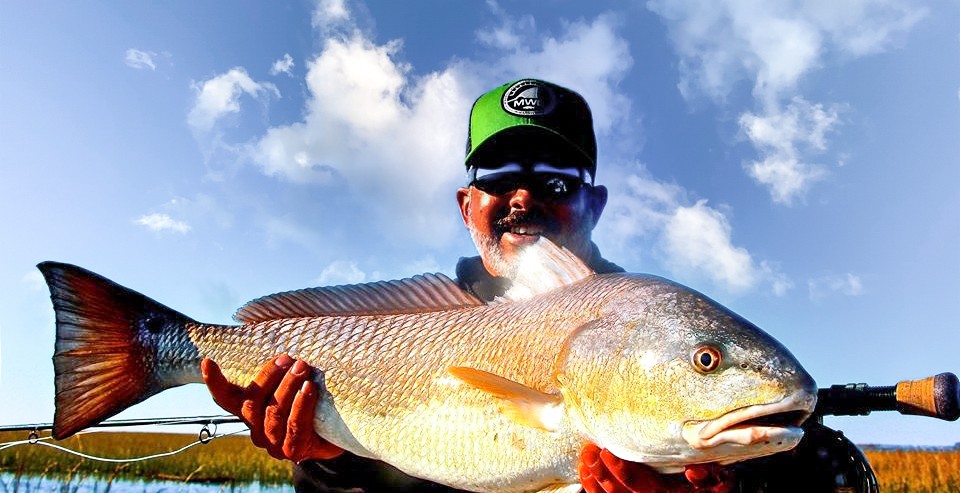
Holbrook lives in Beaufort, South Carolina. He grew up in Manteca, California, and lived in there until graduating high school to attend the United States Naval Academy in 1988. Four years later Holbrook was commissioned as a 2nd Lieutenant in the United States Marine Corps.
“I grew up fishing for trout in the California mountains, but did not start fly fishing until I was 7 or 8 years old.” Holbrook said, “I started fishing for trout in streams on my own when I was 5 years old. I was with my father at a small stream, Deadman Creek, in the Sonora Pass of California. My dad said, “John, this stream is too small and you’re not going to catch any fish.” I told him to leave me alone. My dad walked off a little ways to watch me, and as soon as he left I caught a trout that was about 10 inches. I was hooked on fishing from then on.”
Holbrook made family trips from California to visit his grandfather in Leslie, Idaho. Reading his father’s Field & Stream magazines, he became interested in fly fishing. After finding a bamboo fly rod that belonged to his father, Holbrook was determined to teach himself to fly fish on one of those trips to Idaho.
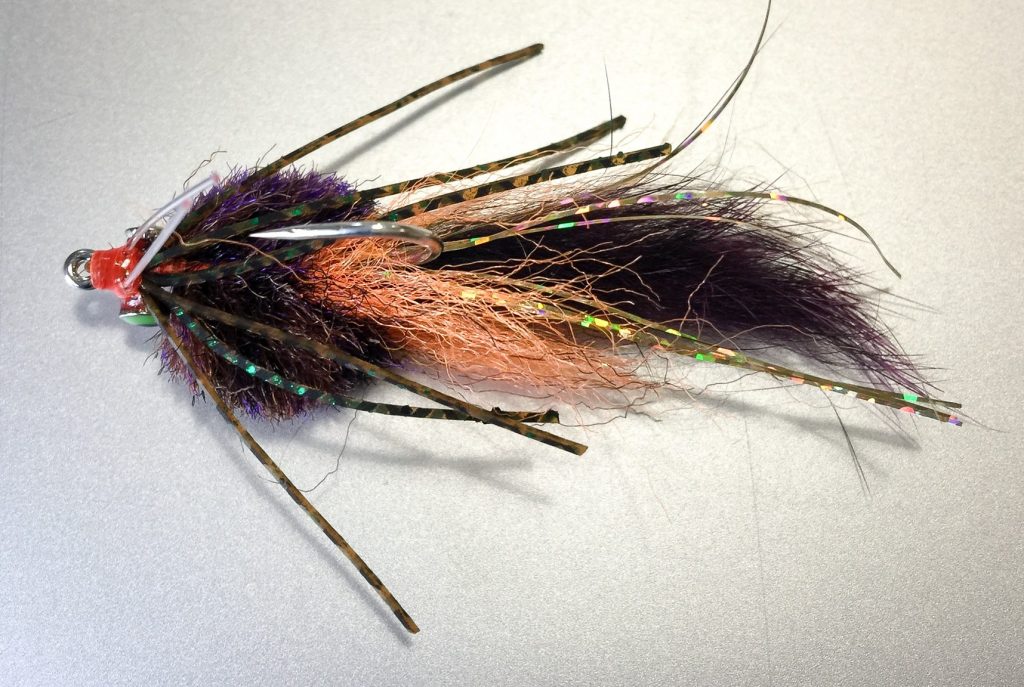
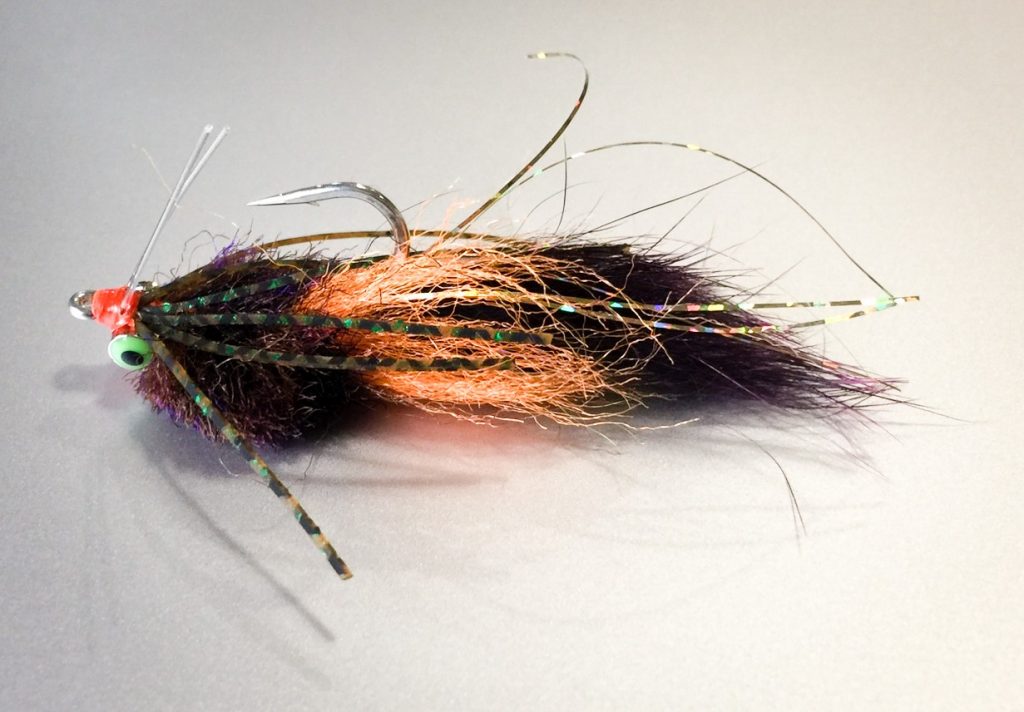
“Once we got into Idaho I saw a big sign that read, “Fly Fishing Only—Catch and Release,” Holbrook said. “The sign stated that the stream was donated in memory of Ernest Hemingway by his family. I bugged my dad incessantly until he finally stopped and let me fish for an hour or so, just to shut me up. I caught a couple of nice 10-, to 12-inch trout and lost a few more in the grass of the stream when a van pulled up in the parking area.
“The van had little dangly balls hanging down across the front inside of the windshield. An older gentleman got out outfitted in classic fly fishing attire. He was tickled to see me fly fishing in the stream. Little did I know at the time just how famous Silver Creek in Idaho really was. He was so glad to see me fishing that he gave me 3 or 4 grasshopper flies and told me to cast them against the undercut bank on the other side of the river. That man was Jack Hemingway, Ernest and Pauline’s son. I didn’t realize the significance of Silver Creek’s history until I was in my early teens.” Holbrook said.
“I started thinking about tying flies as a young boy. I did not have the money, nor anyone that I knew that tied flies, so I did not actually start tying flies until I was at the Naval Academy. Academics were tough, and I had a bad case of cabin fever. My grades were not good, so my liberty was restricted, which made the cabin fever as well as my grades worse. It was at this point that I bought an Orvis beginners fly tying kit and taught myself to tie flies. It actually helped me turnaround my grades,” says Holbrook.
Since settling into the Lowcountry of South Carolina, 80% of the flies Holbrook ties are for redfish, with the remaining 20% for sea trout, cobia, bonefish, and tarpon. Because he ties redfish flies and fishes often for this quarry, Holbrook has developed his “go-to” patterns that work great on coastal waters of the Lowcountry.
“I always carry a crab pattern, a shrimp pattern and a minnow pattern, as well as a couple of Clousers,” Holbrook said. “I always try to have some light colored flies if the water is clear, some medium colored flies if the water is starting to get clouds/stained or the wind is up, and some dark colored flies if the water is stained or at sunrise/sunset when there is not much light.”
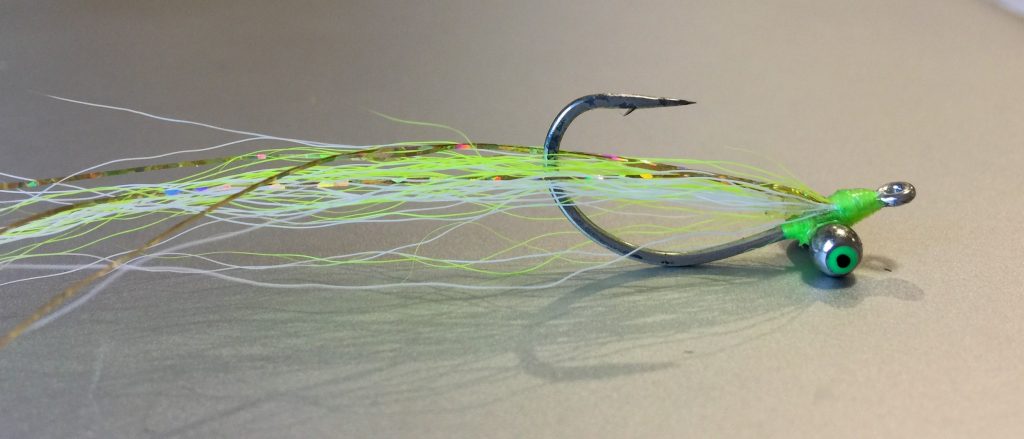
LC Shrimp
“One fly that I recommend is my LC Shrimp (LowCountry), a pattern I first started tying in 2006 or 2007. It has been modified a couple of times and its present form can be seen in the picture below. Another pattern that has performed well for me is my LC Fiddler. This is a fiddler crab pattern I developed to imitate the crabs I see on our high tide flats,” Holbrook said.
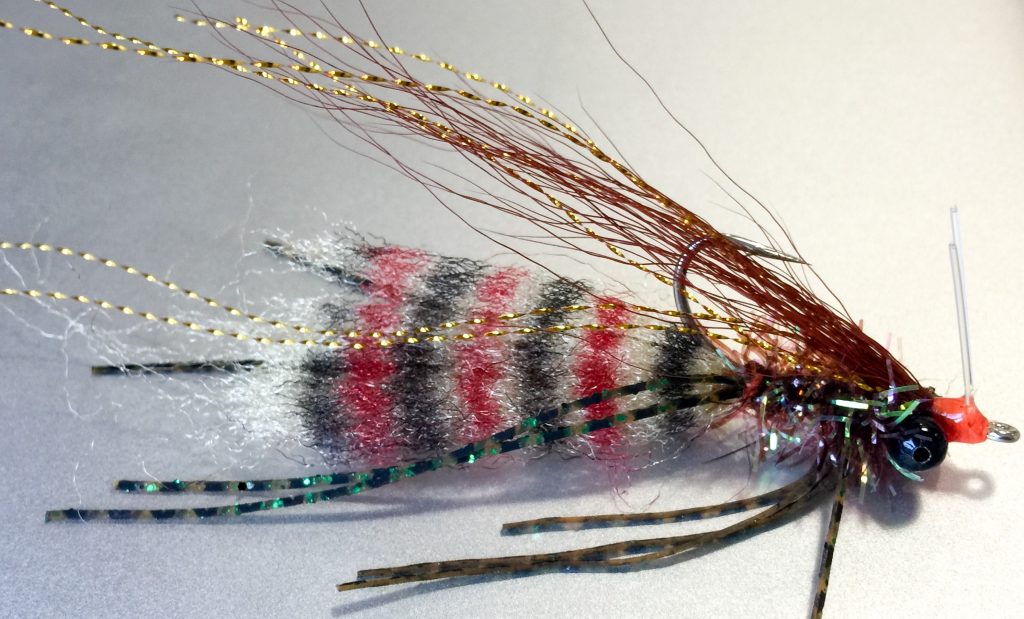
MATERIALS LIST:
- Thread: Danville 210 Thread — Fluorescent Orange
- Hook: Gamakatsu B10 Singer Hook — Size 1
- Hook:Ahrex Predator Stinger Hook — Size 1 Eyes:Bead Chain — Size Large, Black
- Tail:EP Silky Fibers — Tan
- Markers: COPIC Sketch Markers — Black & Red
- Body: Estaz — Root Beer
- Flash:Krystal Flash — Gold
- Legs: Barred Crazy Legs — Golden Yellow/Pearl Flake
- Wing: Bucktail — Root Beer
- WeedGuard: 20#Hard Mason
LC Fiddler
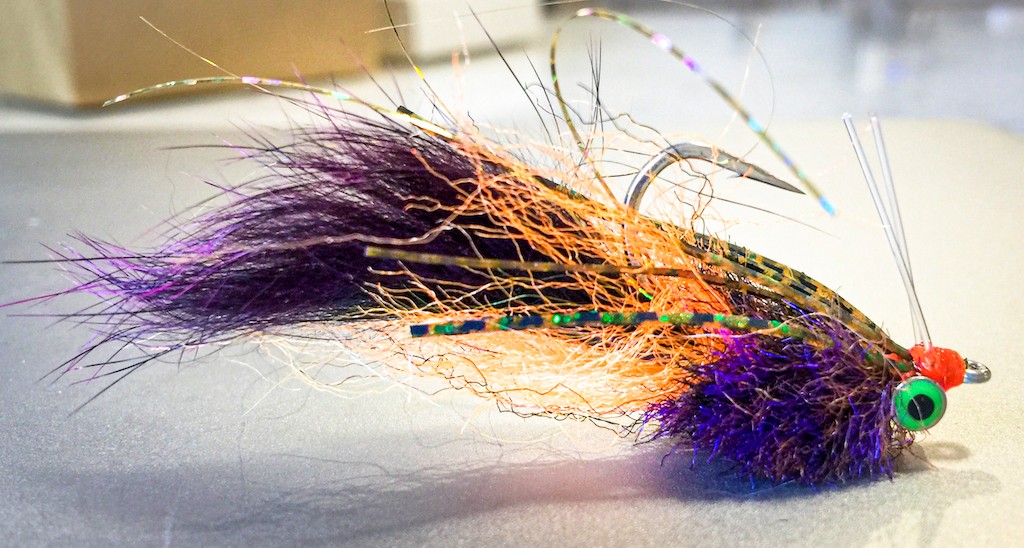
MATERIALS LIST
- Thread:Danville Flat Waxed Nylon, Color: Fluorescent Orange
- Hook:Gamakatsu SC15, Size 1/0
- Eyes:Green Tungsten barbell style, Size Small
- Tail:Hareline Frost-Tip Rabbit strip, Color: Fuscia Butt:EP Tarantula 1” brush, Color: Hot Orange
- Body:EP Fibers, Blend Colors: Brown, Dark Brown, Black & Purple.
- Flash:Use very sparingly, just 2 strands along with legs.
- Legs:Hareline Crazy Legs, Color: Barred Dark Olive
- WeedGuard:20 Lb. Hard Mason mono
LC Ghost Shrimp
“I think that the key characteristics of a great redfish fly are more about color and displacement than any other factors,” Holbrook said. “In clear water with spooky fish, a light colored fly that is sparsely tied will more often than not do much better than a big bulky dark fly. In really stained water, or in low light conditions, I think a dark fly that is tied with more bulk is the ticket. The dark fly is easier for the fish to see in low light, and the bulkiness of the fly displaces more water making it easier for the fish to hone in on the target with its lateral line. I like to go with a fly that is in the middle in conditions that are in between. This is where my LC Ghost Shrimp (LowCountry) excels.
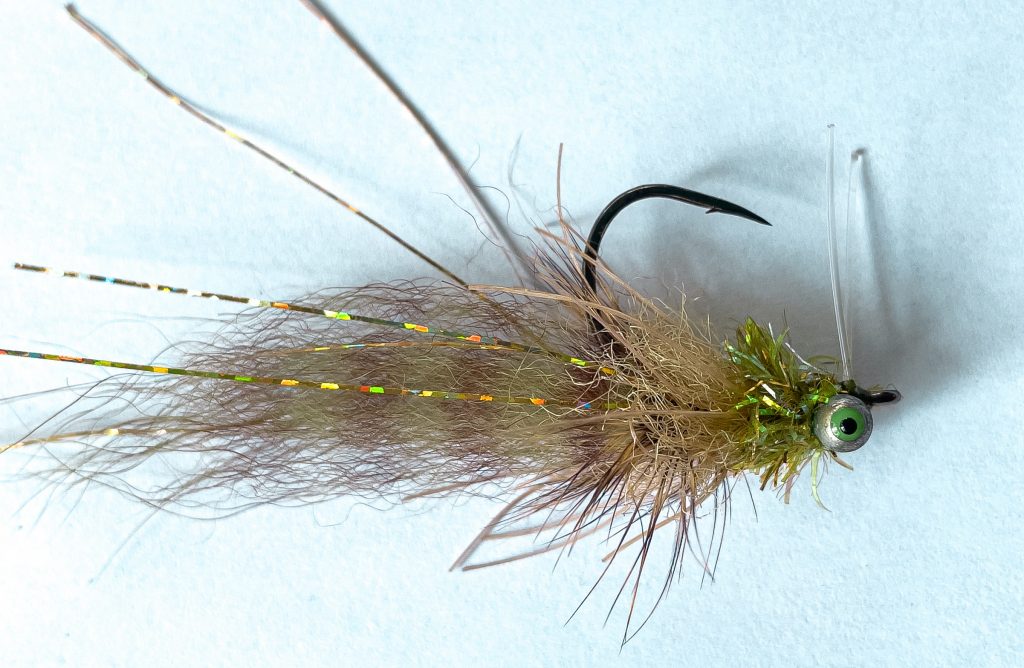
MATERIALS LIST
- Thread: Danville 210 Flat Waxed, Chartreuse
- Hook: Ahrex Curved Gammarus NS 172, Size #2
- Eyes: BallzEyes, Green
- Tail: Arctic Fox Tail, Olive (just like Spanish Moss in Lowcountry)
- Flash: Flashabou, Gold
- Collar: Grizzly soft hackle, Green
- Collar: EP Tarantula 1” Brush, Tan
- Collar: Holographic Cactus Chenille, Olive
- WeedGuard: 20 Lb. Hard Mason mono
“Actively feeding redfish will hit just about any fly. The key is presentation, how you move the fly. In most cases I find short small strips to be my go-to retrieve; think about the quick darting movements of a crab or mud minnow in the grass. When the water is clear, lead a cruising fish more. When it is stained you have to make sure that the fish sees/feels the fly and you may have to almost drop it on his head if he’s digging around.”
Holbrook notes that in the winter and early spring, prior to the water warming up, the water can be pretty clear. For clear water he likes to tie and fish light colored, smaller, and sparsely tied flies that will not spook reds. During the late spring and summer he throws his LC Fiddler pattern about 90% of the time, noting that no matter the season, if you check the contents of a redfish’s stomach you will find crabs. During the late summer and on into the fall Holbrook throws patterns that are a little more “shrimpy”. His LC Shrimp, and anything that is a good shrimp imitation works great. This corresponds to large numbers of grass shrimp in the Lowcountry coastal waters.
When asked about what new fly tying materials he really likes, Holbrook said “I have really enjoyed using the different Enrico Puglisi EP Fiber Brushes, the ready- made brushes are quick and easy to use. I also like Steve Farrar’s Flash Blend.
Even with all of the new products available I find that all of my flies have some natural fibers in them including: Bucktail, Zonker strips, Arctic Fox tail, and Marabou.
“The material that I am currently having the hardest time getting are Black XL Bead Chain Eyes from Wapsi (p/n EYB2006). I used to order them from Spirit River, but they are no longer in business. I use this size bead chain eye in both my LC Shrimp, and my LC White Shrimp pattern. They are the perfect weight and size to allow these flies to drop horizontally like an actual shrimp,” Holbrook said.
This article was originally published in Southern Fly Fishing Issue 2 | SemperFiOnTheFly| June 16, 2017